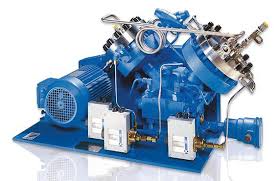
Compressors are devices used for storage of atmospheric air in a high potential-used for pneumatic instruments. Diaphragm compressor is also called membrane compressor which compresses air by a rotating membrane, it draws air into the compression area and pressurises it to be stored in the storage tube section. It consists of a hydraulic Piston system. This is sealed and the bearings are removed so that the ionic liquid does not mix with the gas.
Components For Parts Of Diaphragm Compressor –
- Check valves
- Hydraulic inlet check valve
- Hydraulic piston
- Hydraulic over pump valve
- Over pump sight glass
- Hydraulic injection pump
It is a variant of the old reciprocating compressor with Piston rings and rod seal. The gas compresses by means of a flexible membrane. The moving membrane is driven by a rod and shaft mechanism. With pump gas only the membrane and compressor box come in touch. That is why this is best suited for pumping explosive and toxic gases. The membrane should be reliable to take the strain of pump gas. It should have suitable Chemical properties and sufficient temperature resistance.
How Does The Diaphragm Compressor Work?
It consists of two systems- hydraulic systems and an air pressure system. Metallic diaphragm is a protective component in between the two systems. The air pressure system has three metal plates between two plate cavities as a sandwich, air input and output processes.
The hydraulic crank shaft motor control system Moves the Piston in low pressure. This Piston transfer regulates the hydraulic fluid opposite to lower the side part of the diaphragm, a change is caused in the air process due to the cavities swing. Hydraulic system has some components that can automatically fill the pump, air hydraulic valve and Hydraulic fluid valve pumps excess air.
To make sure that the hydraulic system always meets the pressure rotation, the automatic filling pump senses a fast angler in it after the compressor is off. The check valve protects the hydraulic system for the automatic filler pump when there is a compressive force on the main piston.
Therefore a pressure booster is produced in a system to oppose the hydraulic pump valve.
Advantages Of Diaphragm Compressor
1. Oil free compression as a result of the hermetic separation between oil chamber and gas.
2. Abrasion free compression as a result of static seals in the gas stream.
3. In case of a diaphragm failure, automatic shutdown prevents damage.
4. Discharge pressure upto 3000 bar.
Diaphragm compressors are a preferred choice for contamination free and leak tight gas compression. They provide outstanding results from an efficiency perspective.
Safety – on all PDC diaphragm compressors standard diaphragm or failure leak detection systems are provided. Like- PDC machines manufacturers diaphragm process gas compressors for industrial gas compression applications.
PDC leads the industry in diaphragm life. Since 1977 PDC machines have been manufacturing industrial diaphragm gas compressors. PDC diaphragm compressors are the preferred choice for any application when there is a requirement for high purity and leak tight gas compression. They design basic to fully instrumented leak free, non contaminating reciprocating diaphragm gas compression systems.